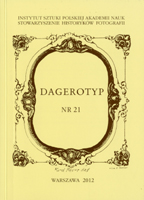Zaczęło się od dagerotypów mikroskopowych. Początki fotografii we Wrocławiu
It all started with microscopic daguerreotypes. The beginnings of photography in Breslau
Author(s): Zygmunt WielowiejskiSubject(s): Photography
Published by: Instytut Sztuki Polskiej Akademii Nauk
Keywords: photography; german photography; silesian photography; vintage photography; old photographic technique; daguerreotype; microscopic photography; portrait photography; Breslau; Wrocław;
Summary/Abstract: The article gives a detailed description of the beginnings of photography in Breslau (today’s Wrocław) between 1839 and 1860, including daguerreotype and early photography on paper. The main sources for this article were press advertisements and address books dating from that time. Two scholars, Johann Heinrich Robert Göppert, a physician and botanist, and Johann Gebauer, secretary of the Silesian Society for National Culture and director of the school of arts and crafts first attempted to make daguerreotypes back in 1839. They tried to produce pictures of preparations under a microscope, but their results were unsatisfactory, so they discontinued their attempts. Carl Ferdinand Langhans, an architect from Breslau, may also have been making daguerreotypes in 1839; in the summer of 1840 he exhibited two daguerreotype images of the city at the “Fifth exhibition of national technical art”. Three years later, in 1843, Hermann Krone, who came from Breslau, and who later became a renowned daguerreotypist and photographer in Dresden, began experimenting with photography. At that time he was also studying at the University of Breslau and before he left the city for good in 1849, he made talbotypes and then daguerreotypes, of which nine have survived. In the same year, the first two professional daguerreotypists arrived in Breslau. Julius Brill was the first to open a studio. Later seven travelling daguerreotypists arrived in the city: the brothers H. and W. (?) Lexow, Wolff, de la Haye, Kolbe and two other anonymous people. Eduard Wehnert travelled to Breslau at the beginning of 1844 and stayed there for the whole of 1845. The Lexow brothers, de la Haye and an anonymous daguerreotypist also arrived in the city in 1844, whereas H. Lexow and three new daguerreotypists: Burkhard, Adolf Otto and an anonymous person visited the city next year. The Breslau address books first included the new profession in 1846, classifying Carl Wilhelm Böhm, Brill, W. (?) Lexow, Adolph Otto, Carl Staritz and Eduard Wehnert as daguerreotypists. The book dating from 1847 included only four daguerreotypists (Böhm, Otto, Julius Rosenthal and Staritz), while the book dating from 1848 included three, previously mentioned representatives of this profession (Otto, Rosenthal and Staritz), and the books dating from 1849 and 1850 again included four daguerreotypists (Lobethal, Böhm, Rosenthal and Staritz). The years 1852-1853 brought significant changes to the technique used for making photographs, starting with the arrival in Breslau of Carl August Lau in June 1851, as well as the arrival in September of that year of C. von Wieland. The era of the daguerreotype ended in the 1850s. Between 1843 and 1860 there were 33 professional daguerreotypists working in Breslau.
Journal: Dagerotyp
- Issue Year: 2012
- Issue No: 21
- Page Range: 5-62
- Page Count: 58
- Language: Polish
- Content File-PDF

